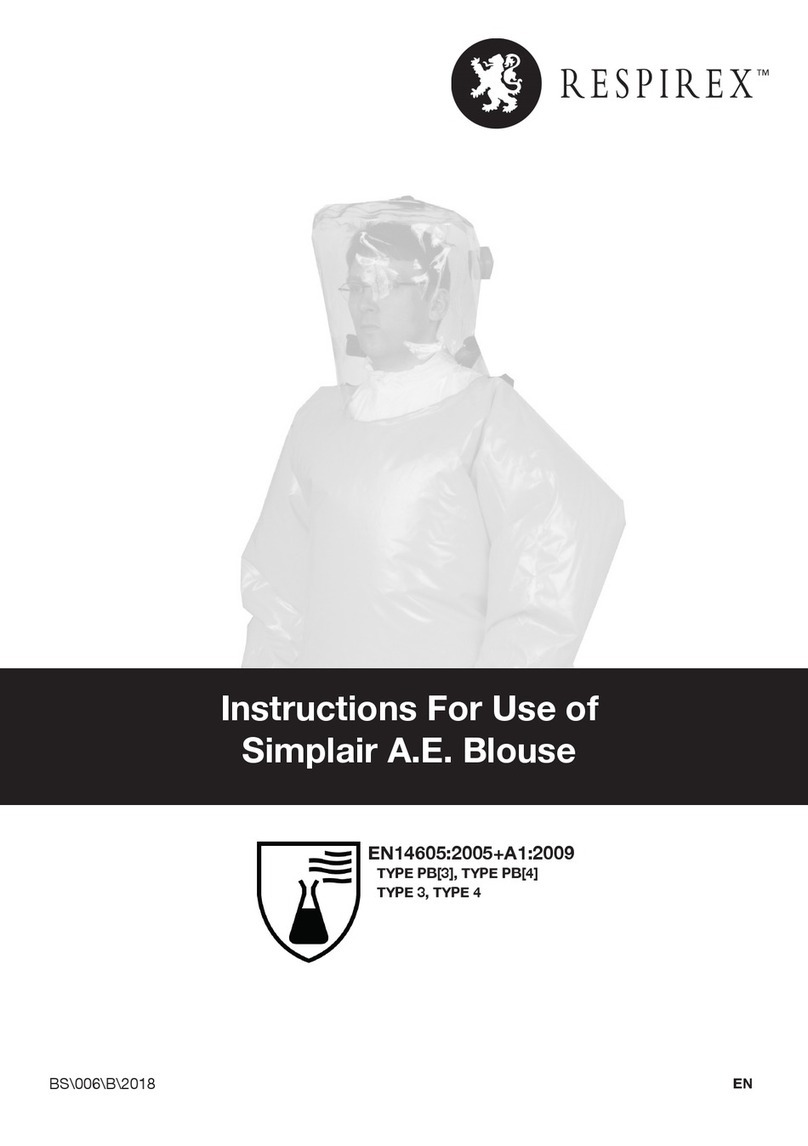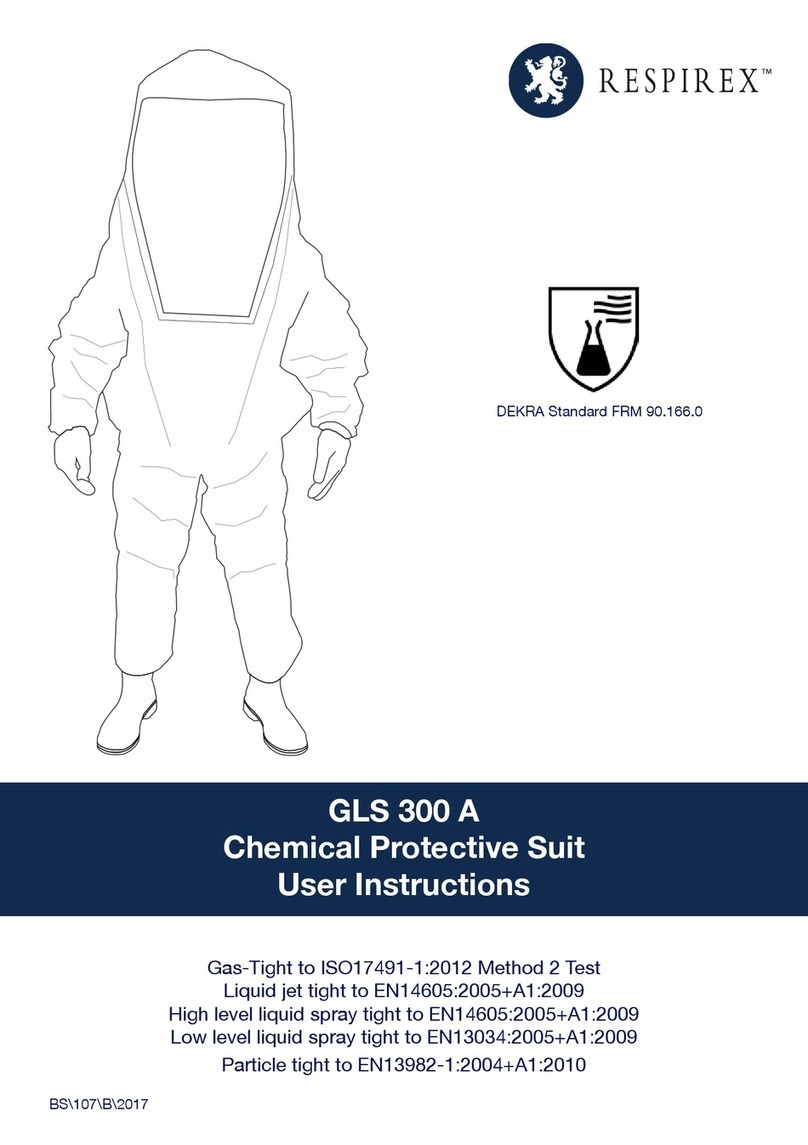
10
Instructions For Lifting Harness (Tank Suit Only)
WARNING : The facility must only be used in conjunction with a back ‘D’ ring xing full body harness approved
to EN 361 : 1992. Always follow closely the manufacturer’s recommendations for use, inspection and cleaning
of safety belts and harnesses. This facility is designed for positioning purposes only, i.e. lowering into and
out of tanks or vessels. It should NEVER be worn as a means of arresting falls. Respirex cannot guarantee
the integrity of any suit used in such circumstances.
1. Don the body harness according to manufacturer’s instructions
ensuring that the back ‘D’ ring lifting point is between the wearer’s
shoulder blades. See Fig 23.
2. Don the Simplair Tanksuit as outlined on pages 7&8 as far as stage 8.
3. Pull the lifting harness trunk of the Simplair Tanksuit inside out and
down towards the lifting point of the full body harness. Unscrew the
locking nut of the ‘quick-link’ and connect to the ‘D’ ring on the full
body harness. Screw the locking nut on the ‘quick-link’ to the fully
locked position. See Fig 24.
4. Complete the donning procedure for the Simplair Tanksuit as
described on page 8.
5. Connect the line from the lifting system to the ‘quick-link’ on the
exterior of the Simplair Tanksuit. Ensure that the locking nut on the
‘quick-link’ is screwed to the fully locked position.
NOTE : When a Simplair suit is being worn in conjunction with a lifting
harness, the trunk at the rear of the hood must concertina at towards
the wearer’s neck. This is to ensure that when the wearer is lifted the
movement of the harness is taken up by the trunk. This prevents damage
occurring to the suit. See Fig 25.
Inspection And Replacement Of Component Parts
A regular inspection and replacement program should be conducted by employees.
The Respirex air supplied suit and all component parts and assemblies should be inspected for damage or
excessive wear before and after each use to ensure proper functioning. Immediately remove the suit from
service and replace parts or assemblies that show any sign of failure or excessive wear that might reduce the
degree of protection originally provided.
Use only Respirex components and replacement parts.
Instructions For Lifting Harness (Tank Suit Only)
WARNING : The facility must only be used in conjunction with a back ‘D’ ring fixing
full body harness approved to EN 361 : 1992. Always follow closely the
manufacturer’s recommendations for use, inspection and cleaning of safety belts and
harnesses. This facility is designed for positioning purposes only, i.e. lowering
into and out of tanks or vessels. It should NEVER be worn as a means of
arresting falls. Respirex cannot guarantee the integrity of any suit used in such
circumstances.
1. Don the body harness according to manufacturer’s
instructions ensuring that the back ‘D’ ring lifting point is
between the wearer’s shoulder blades. See Fig 23.
2. Don the Simplair Tanksuit as outlined on pages 7&8asfar
as stage 8.
3. Pull the lifting harness trunk of the Simplair Tanksuit inside
out and down towards the lifting point of the full body
harness. Unscrew the locking nut of the ‘quick-link’ and
connect to the ‘D’ ring on the full body harness. Screw the
locking nut on the ‘quick-link’ to the fully locked position.
See Fig 24.
4. Complete the donning procedure for the Simplair Tanksuit
as described on page 8.
5. Connect the line from the lifting system to the ‘quick-link’
on the exterior of the Simplair Tanksuit. Ensure that the
locking nut on the ‘quick-link’ is screwed to the fully locked
position.
NOTE : When a Simplair suit is being worn in conjunction
with a lifting harness, the trunk at the rear of the hood must
concertina flat towards the wearer’s neck. This is to ensure
that when the wearer is lifted the movement of the harness is
taken up by the trunk. This prevents damage occurring to the
suit. See Fig 25.
10
Fig.23
Fig.24
Fig.25
Fig. 23
Instructions For Lifting Harness (Tank Suit Only)
WARNING : The facility must only be used in conjunction with a back ‘D’ ring fixing
full body harness approved to EN 361 : 1992. Always follow closely the
manufacturer’s recommendations for use, inspection and cleaning of safety belts and
harnesses. This facility is designed for positioning purposes only, i.e. lowering
into and out of tanks or vessels. It should NEVER be worn as a means of
arresting falls. Respirex cannot guarantee the integrity of any suit used in such
circumstances.
1. Don the body harness according to manufacturer’s
instructions ensuring that the back ‘D’ ring lifting point is
between the wearer’s shoulder blades. See Fig 23.
2. Don the Simplair Tanksuit as outlined on pages 7&8asfar
as stage 8.
3. Pull the lifting harness trunk of the Simplair Tanksuit inside
out and down towards the lifting point of the full body
harness. Unscrew the locking nut of the ‘quick-link’ and
connect to the ‘D’ ring on the full body harness. Screw the
locking nut on the ‘quick-link’ to the fully locked position.
See Fig 24.
4. Complete the donning procedure for the Simplair Tanksuit
as described on page 8.
5. Connect the line from the lifting system to the ‘quick-link’
on the exterior of the Simplair Tanksuit. Ensure that the
locking nut on the ‘quick-link’ is screwed to the fully locked
position.
NOTE : When a Simplair suit is being worn in conjunction
with a lifting harness, the trunk at the rear of the hood must
concertina flat towards the wearer’s neck. This is to ensure
that when the wearer is lifted the movement of the harness is
taken up by the trunk. This prevents damage occurring to the
suit. See Fig 25.
10
Fig.23
Fig.24
Fig.25
Fig. 24
Instructions For Lifting Harness (Tank Suit Only)
WARNING : The facility must only be used in conjunction with a back ‘D’ ring fixing
full body harness approved to EN 361 : 1992. Always follow closely the
manufacturer’s recommendations for use, inspection and cleaning of safety belts and
harnesses. This facility is designed for positioning purposes only, i.e. lowering
into and out of tanks or vessels. It should NEVER be worn as a means of
arresting falls. Respirex cannot guarantee the integrity of any suit used in such
circumstances.
1. Don the body harness according to manufacturer’s
instructions ensuring that the back ‘D’ ring lifting point is
between the wearer’s shoulder blades. See Fig 23.
2. Don the Simplair Tanksuit as outlined on pages 7&8asfar
as stage 8.
3. Pull the lifting harness trunk of the Simplair Tanksuit inside
out and down towards the lifting point of the full body
harness. Unscrew the locking nut of the ‘quick-link’ and
connect to the ‘D’ ring on the full body harness. Screw the
locking nut on the ‘quick-link’ to the fully locked position.
See Fig 24.
4. Complete the donning procedure for the Simplair Tanksuit
as described on page 8.
5. Connect the line from the lifting system to the ‘quick-link’
on the exterior of the Simplair Tanksuit. Ensure that the
locking nut on the ‘quick-link’ is screwed to the fully locked
position.
NOTE : When a Simplair suit is being worn in conjunction
with a lifting harness, the trunk at the rear of the hood must
concertina flat towards the wearer’s neck. This is to ensure
that when the wearer is lifted the movement of the harness is
taken up by the trunk. This prevents damage occurring to the
suit. See Fig 25.
10
Fig.23
Fig.24
Fig.25
Fig. 25





























